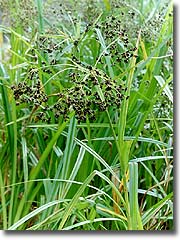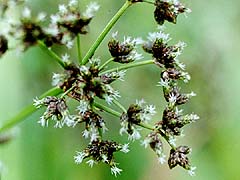
"Sedges have edges." The rule to remember in identifying members of Cyperaceae - and although those edges are sometime pretty subtle, it holds true for our native species.
They all grow in wet areas, if not right in creeks and ponds, which is another clue. Stems are usually solid and three-angled (those edges - you may have to slice it toward the base to really see it). The leaves, when present, are slender but with a substantial stem clasping basal sheath with fused edges.
The flowers (or florets in this case) are clustered in spikelets, with bracts at each floret as well as the spikelet itself. There is usually 3 stamens, and 2 to 4 feathery stigmas on the pistil.
| Cyperus sp. Nutgrass |
Scirpus californicus California Bulrush |
| Scirpus microcarpus Panicled Bulrush |
Scirpus pungens Common Threesquare |



